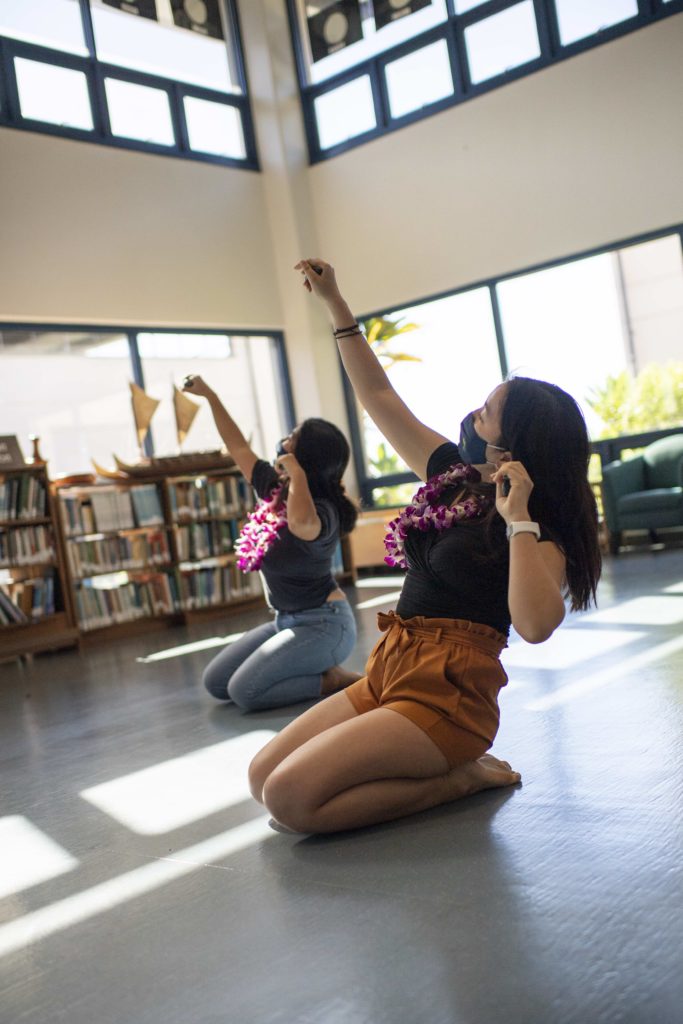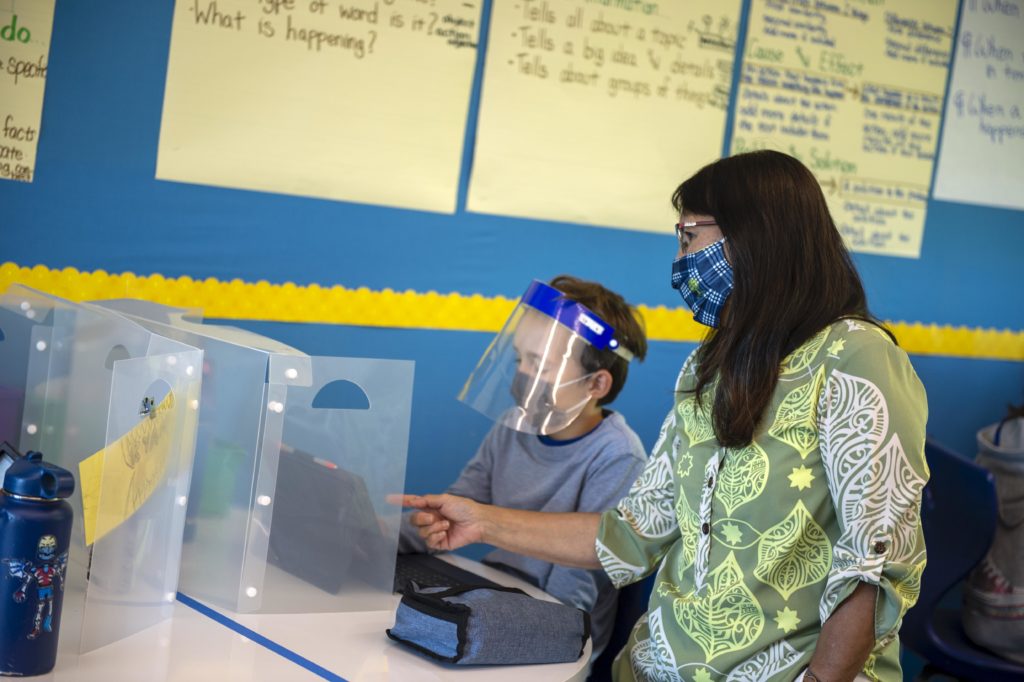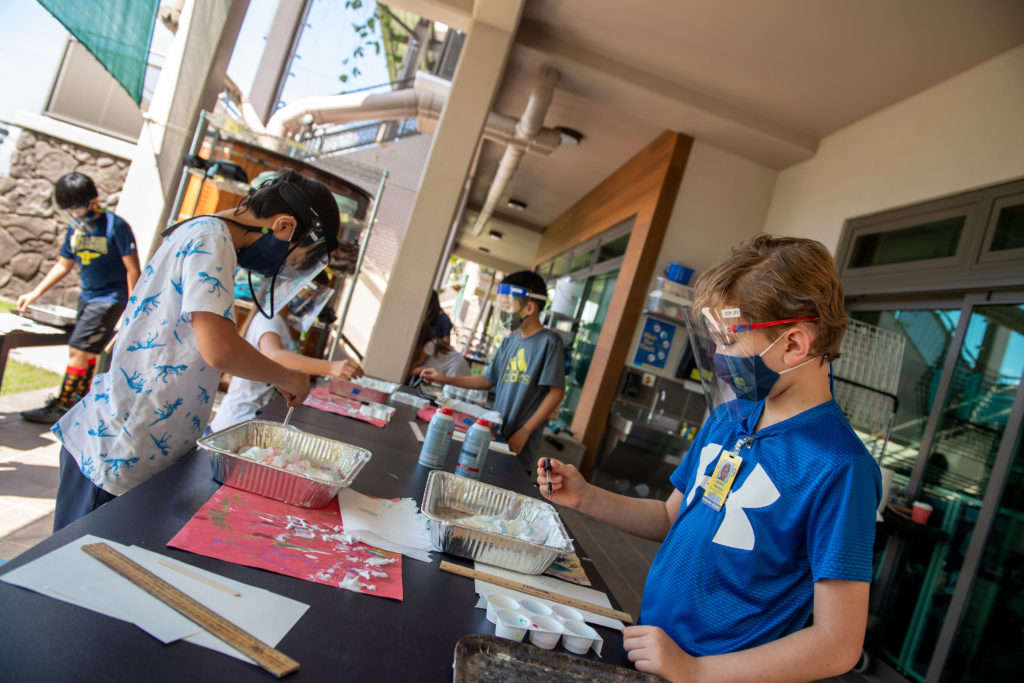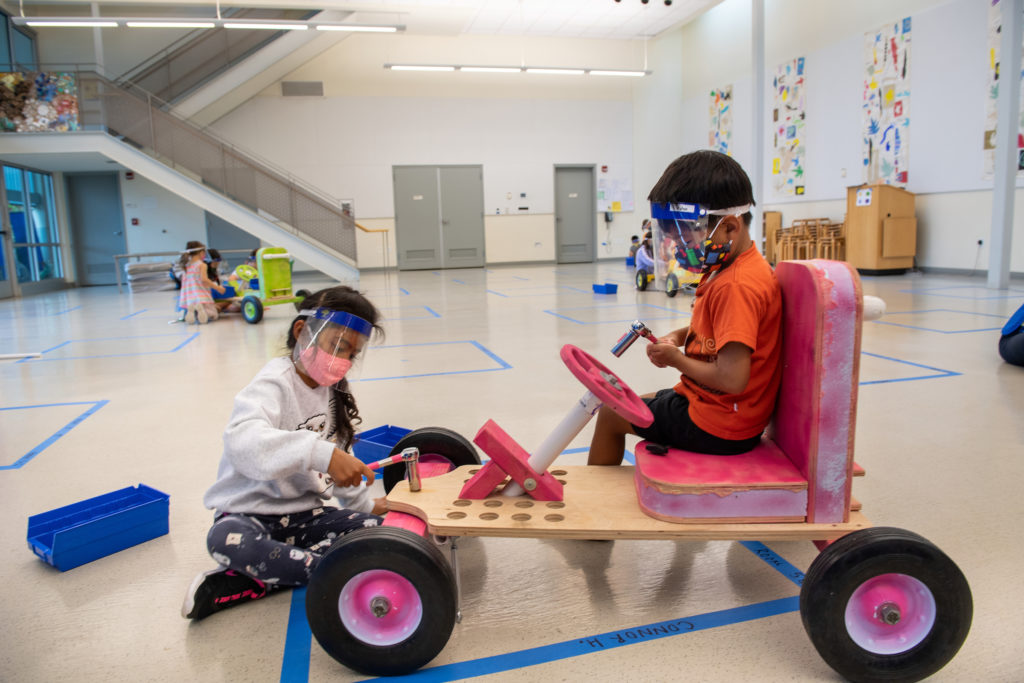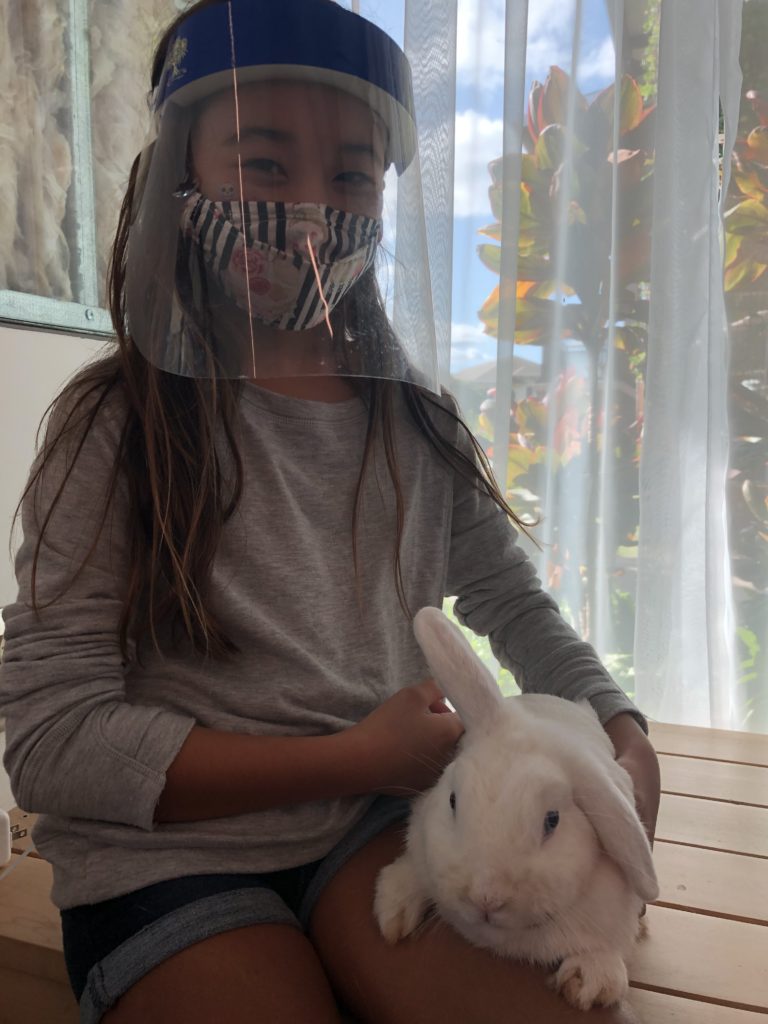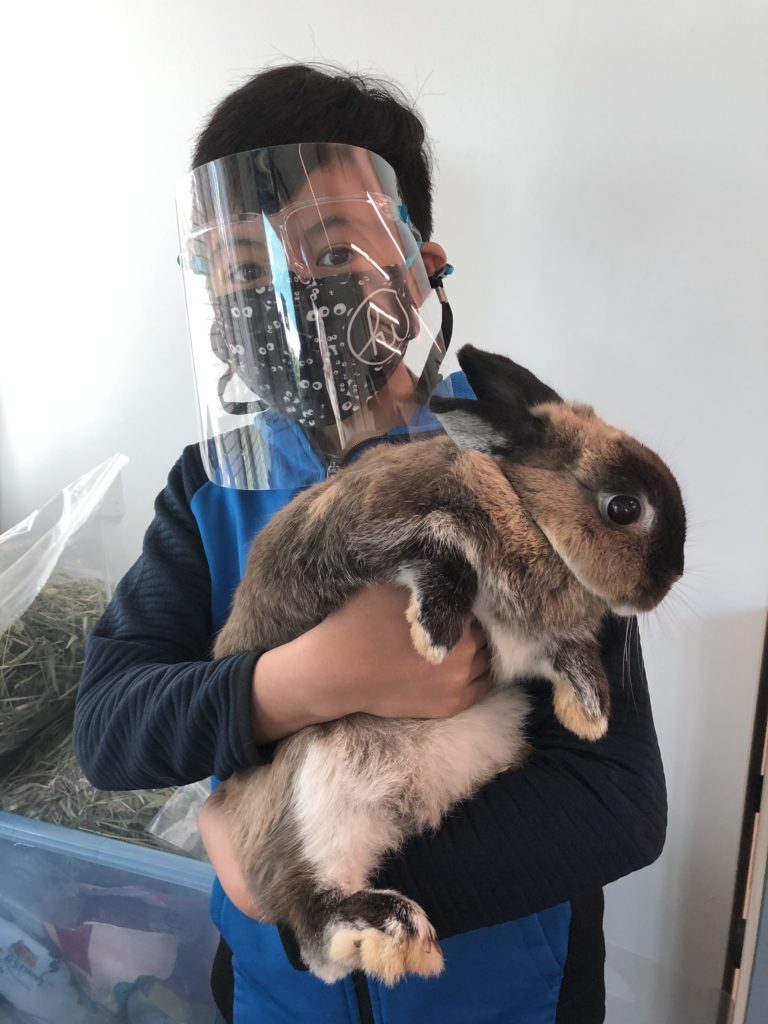Despite various safety and health protocols in place, Punahou students across grade levels are taking part in the same core curriculum of past years. Over the course of the current school year, we’ll be checking in with faculty members across campus to see how they are teaching and engaging students.
Punahou Students Connect with Peers in Argentina
In Kuaihelani Learning Center, Kimo Keaulana, an ‘Ike Hawai‘i faculty member and kumu hula, led Academy Hula Explorations students in a hula during a virtual visit with students from Argentina, which was coordinated by Paula Arias, director of Strategic Programs at the Wo International Center. Students shared a welcoming chant (mele kāhea) and hula chant with the Argentinian students. An Argentinian dance instructor later taught students how to dance “El Gato,” an Argentine folklore dance.
Third Grade Students Learn About the Ahupua’a
The third graders in ‘Ike Hawai‘i faculty member Emma McGuire’s ’93 class are studying the Hawaiian concept of the ahupua’a. Students learned a call-and-response spoken mele as well as lessons about kapa making. They then created pictures to illustrate the water cycle within an ahupua’a, which incorporated kapa designs.

Learning about the Island’s Water Cycle
In Maxine Nu’uhiwa’s ‘Ike Hawai’i lesson, fourth grade students learned about the water cycle through learning the mele, “He Mele no Kāne,” studying the water cycle in ʻŌlelo Hawaiʻi, discussing the importance of fresh water and learning about the Makahiki, or wet season.
Just Dance Club Brings Joy to Kūpuna
Academy students and advisor Marci Ching of the Just Dance Club haven’t let the pandemic stop them from dancing or giving back to the community. Before the pandemic, students from the club previously took a field trip to Shriners Hospitals for Children to dance with keiki. Now, they are sharing their dance moves online, to songs such as “Can’t Take My Eyes Off of You” and the “Macarena,” with some of the residents at the Arcadia retirement community.
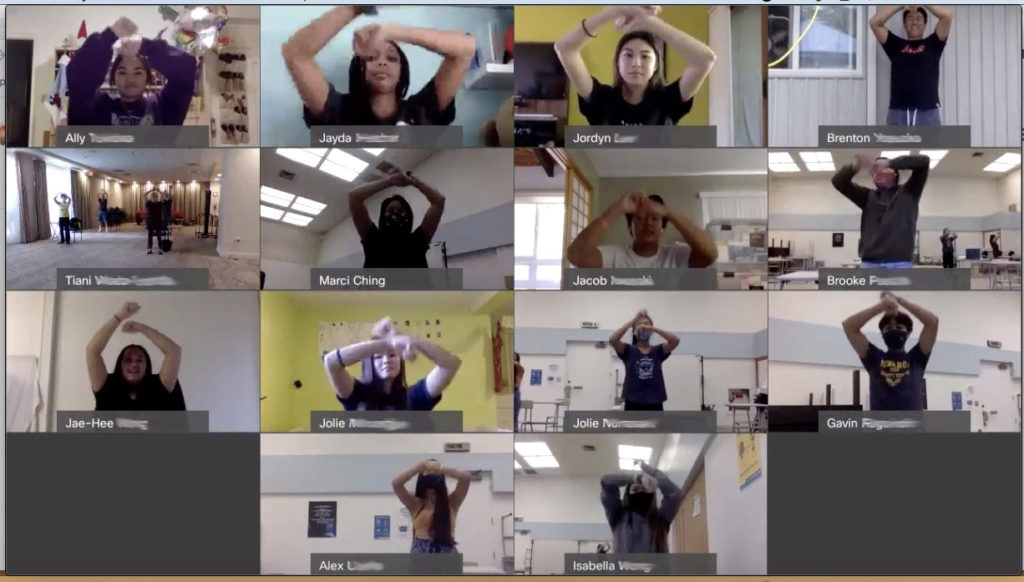
Art Meets Science in 4th Grade
Fourth graders explored water through a week of water-themed art projects in tandem with other classroom lessons on the subject. Students conducted four hands-on experiments: surface tension photography, shaving cream prints, floating chalk prints and suminagashi (Japanese marbling).
The printing techniques taught students about surface tension, which allows bugs to stride on top of water. This same property allows ink and chalk to stay on top of water and be printed onto paper. Students also learned about surfactants, like soap in shaving cream, which lower surface tension.
Acting as artists and scientists, students recorded their observations and could reproduce the projects at home if they chose to. “At the end of the week, students turned their beautiful printed papers into cards, bookmarks and boxes,” said Katie Snyder, the art specialist for grades 2 – 5 who coordinated the project.
To ensure safety, each student had their own set of tools. “This requires more set up and take down, but I really wanted to give the kids an experience that is super interesting and engaging even though it is very supply intensive,” said Snyder. “This is an experience that can only be created on campus. These experiments really highlight Punahou’s approach to art by highlighting process over product and an emphasis on exploration and observation.”
Go-Karts in the K – 1 Neighborhood
Working in teams of two, Punahou’s youngest learners put together push go-karts using design thinking and fabrication skills. They then navigated them through a route created at the Omidyar K – 1 Neighborhood.
The project has become an annual highlight among students. Taryn Loveman, director of design technology and engineering, said faculty Mike Trusso and Ade Ogunniyi adapted the project to fit with safety protocols this year. Instead of having four or five students working on one go-kart, the team fabricated additional go-kart parts in one of the School’s fabrication and design labs, the D. Kenneth Richardson ’48 Learning Lab, so fewer students could work on more go-karts.
“We made them smaller with more parts to assemble so that we could have just two kids working on each kart with their own tool set, which was disinfected between use,” Loveman said. “We also improved the steering radius for tighter indoor courses, added customizable seat positions, a buildable steering linkage and, compared with last year’s go-karts, these carts can be completely disassembled using only ratchets and sockets.”
The go-karts were just one of many projects completed by lab managers and K – 12 design technology and engineering faculty to adapt curriculum to new health guidelines, while retaining the creativity and joy of the original lessons. “I’m proud of what the faculty have accomplished for our students, as teachers at every grade level rose to the challenge,” Loveman said.
Academy JROTC Cadets Connect with a Variety of Guest Speakers
Inspired by this year’s school theme of kuana‘ike (perspective), the JROTC WebEx virtual guest speaker program has been well received by JROTC cadets. “These brief talk story sessions relate to personal life journeys and life lessons learned,” said Punahou JROTC Director LTC Ret. Robert Takao. “The speaker program has resulted in cadets reflecting on their own dreams and choices as they navigate through these times.”
Speakers have included nearly 30 different Punahou school leaders, alumni and others from the mainland and Hawai‘i, including Jaclyn Woo ’01, who works in marketing and sales at Google, Air Force pilot Tommy Takao ’12 and Josephine van der Voort, from the FBI.

Learning About Machines Through Legos
In a lesson by design technology and engineering faculty member Jordan Ushijima ’97, fourth graders used legos to learn about simple machines. As part of the one-week lesson, students learned about wheels and axles. “Each student had their own lego kit and instruction booklet so all of the pieces that they use are not touched by anyone but themselves,” said Ushijima. Lego pieces were also sanitized.

Seniors Find Ways to Help the Community
As part of their required Senior Capstone course, students delved into themes of social responsibility, the environment and community service despite the restrictions accompanying COVID-19.
“I was struck by the ingenuity and creativity of the students’ individual projects in which they succeeded in conducting meaningful service ‘from their bedrooms,’ as one senior put it,” said Pam Sakamoto, the Academy Social Studies department head and one of the Capstone faculty members. “I had been anxious about how Capstone – an inherently outward-oriented – would be successful. The students made it work!”
Here is a sampling of student projects: Senior Ella Fontenot ’21 created coding lessons for students to access online. One student produced over 100 masks and donated them to The Institute for Human Services. Another student illustrated a children’s book on sea level rise and read it to second graders at Punahou. Grace Matsumoto ’21 created a Korean language website with resources on COVID-19 after overhearing her mother talking about Korean-speaking friends who could not access accurate, timely information about COVID-19. Patrick Munley ’21 is getting a project underway to deliver food to a center for homeless youth, called Youth Outreach at Waikiki Health. Through Red Cross, Kemi Chung ’21 helped identity and map communities that are missing from the maps that responders use to deliver lifesaving aid. She also created an infographic on the connection between heart disease and COVID-19.
Music Plays on at Middle School
Case Middle School students are experiencing music in new ways this year, taking advantage of opportunities to connect with classmates while continuing to develop their musical skills. Although students aren’t able to make music together because of safety protocols in place, music instruction has carried on.
“The new school schedule necessitated by COVID-19 programming presented challenges which talented faculty have turned into new and interesting music learning opportunities for our students,” said Alicia Scanlan, K – 12 Music Department Head (Junior School).
Middle school students are now offered a variety of quarter units in general music, and are participating in virtual Ensemble Project Time with their cohorts in orchestra, band and choir. General music classes include music theory, music composition, origins of different instruments, history of musical theatre, Mele Aloha ʻĀina, music in media and social activism through the lens of music.
Troy Sarsuelo ‘25 said he’s been happy to connect with others in his choir ensemble cohort, especially with sports on pause. “To have a way to connect and ‘see’ my choir friends once a week has been a bright spot!” he said.
Megan Yamamoto ‘25 said she’s likes the addition of general music, instead of just taking orchestra. “The first unit was music genres, and we got to explore and listen to tons of new music,” she said. “I’ve gained a sense of appreciation for music greater than I ever had before. All in all, although this year has been different, I’m super grateful that I get to have this experience.”

Learning Thrives Outside
Students in grades 4 and 5 enjoyed fresh air and time with nature while helping populate the Kosasa Community with indigenous plants as part of the Outdoor Education program. Students repotted ‘a‘ali‘i seedlings sprouted by high schoolers on Pu’u o Mānoa (Rocky Hill), and were inspired by the Hawaiian ‘Olelo No’eau, which says, “He ‘a‘ali‘i kū makani mai au; ‘a‘ohe makani nāna e kula‘i” or “I am a wind-resting ‘a‘ali‘i; no gale can push me over.”
“We talk to the kids about how the ‘a‘ali‘i plant reminds us to be strong, resilient, flexible, and that any challenges that come their way, or our way, we can meet,” said Outdoor Education faculty member Shelby Ho ’01. “This lesson is really pertinent in life, but also right now.”

Exploring Science in 8th Grade
In Case Middle School faculty member Erin Flynn’s science class, 8th grade students learned how the different phases of matter respond to changes in temperature. For the experiment, students heated and cooled water, then observed how heating caused the liquid to expand, whereas cooling caused the liquid to contract. This was in conjunction with another lesson where students used pressure to expand and contract a gas, and learned how gas and liquid differ in their physical properties.
5th Graders Take Joy in Caring for Rabbits
Fifth grade faculty member Rebecca Wagner’s students are learning to care for their class bunnies, Mochi and Koa, who are loving their rabbit hutch built over the summer by the Outdoor Education department. Wagner says the rabbits are a part of the class community, and students are learning how to groom them and keep their habitats clean.
The bunnies have been a source of comfort for students, creating a sense of calm in the classroom. Students read books outside near the bunnies and take turns holding them. “Over the years, I’ve had many students who have learned pet care in the classroom write persuasive essays to their parents about why they should have pets at home,” Wagner said. “Likewise, the bunnies are helping the students find connections to one another. Sometimes the kids have a common interest in animals and end up becoming friends.”
Coding Video Games in 3rd Grade
Third graders created simple video games using small magnetic electronic kits during a design technology and engineering lesson. They rigged up circuit boards and used coding to create interactive games. One student created a shooting game which kept score as the player hit a target with a paper ball. Another student made a two-player digital tug of war game.
“Students created their own game character images and controllers,” explained Liz Castillo, a design technology and engineering faculty member, who taught the lesson. To ensure safety, students worked on their own kits instead of sharing them.
Academy Teaching Assistants Challenge Each Other with Physics Problems
The two student teaching assistants in Academy faculty member Tiffany Coke’s AP Physics classes have been creating physics problems to challenge and entertain each other in their downtime. In the video below, Noah Chung ’22 successful solves a problem left for him by Jonah Johnson ’21, which involves using projective motion and energy to solve a mini-Rube Goldberg experiment. Students fired a projectile from a launcher, sent it around a loop and then tried to land it into a cup. “They both filled at least two whiteboards with calculations trying to figure out these challenges,” Coke said.
The two students have posed other questions to challenge each other, including, “If I were to spin around with my arms out, how fast would my angular velocity have to be to make my knuckles crack?” and “If there was nothing in the universe but me and the Sun, how long would it take for gravity to bring me close enough to the Sun to burn me?”
Academy Students Engage with Kūpuna
As part of a community service project, Academy Social Studies faculty member Yunus Peer’s Senior Capstone class led the kūpuna at Kaiser Permanente in chair yoga, bingo, hula and Jeopardy through regular virtual sessions.
One student shared their thoughts about the experience, “I enjoyed volunteering. I thought I wouldn’t have the chance to get much or even any valuable community service because of COVID-19, but I’m glad that I was able to. I enjoyed putting together a plan and practicing for our sessions with kūpuna. I think we did something good.” Another student shared this about leading kūpuna in bingo, “It was great to hear them having a good time with bingo and to be able to brighten their day up, especially with this pandemic looming over society.”



